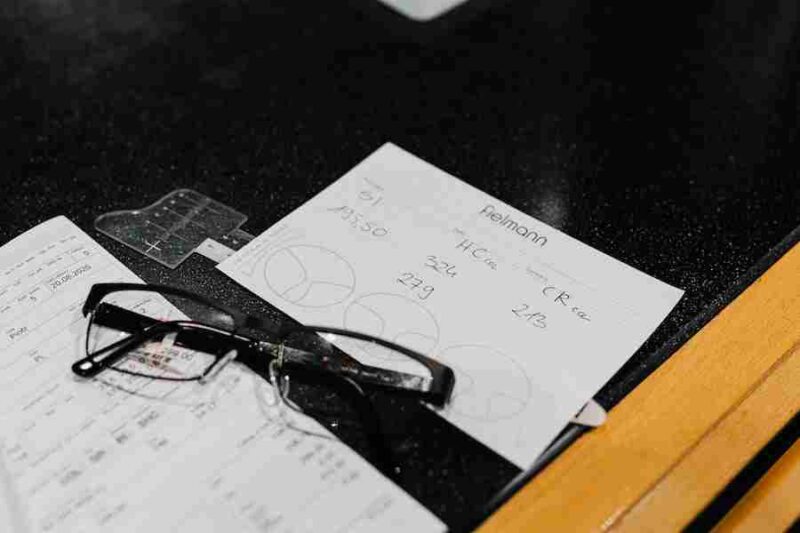Your eyeglass prescription plays a crucial role in ensuring clear vision and addressing specific visual needs. But have you ever wondered how long an eyeglass prescription lasts? Knowing the lifespan of your prescription is essential for maintaining optimal eye health and vision. In this article, we will explore the factors that affect the durability of eyeglass prescriptions, discuss typical durations for different prescription types, and highlight the signs that indicate it’s time for a new prescription. Understanding the longevity of your eyeglass prescription is key to enjoying clear and comfortable vision.
How Long Does Eyeglass Prescription Last?
Eyeglass prescriptions typically last for about one to two years. However, the exact duration may vary based on factors such as changes in vision, eye health conditions, and lifestyle. It is recommended to have regular eye exams to ensure that your prescription is up to date and to address any changes in your vision or eye health.
Understanding Eyeglass Prescriptions
Eyeglass prescriptions may seem complex, but once you grasp the basic components and terminologies, it becomes easier to comprehend. A typical eyeglass prescription consists of several measurements that determine the corrective power needed for each eye.
The main measurements in an eyeglass prescription are sphere (SPH), cylinder (CYL), and axis. Sphere (SPH) indicates the amount of nearsightedness (negative values) or farsightedness (positive values). The cylinder (CYL) measures the amount of astigmatism, and the axis denotes the orientation of the astigmatism correction. Additionally, there is the addition (ADD) measurement for bifocal or multifocal prescriptions, which indicates the additional power required for close-up vision. Pupillary Distance (PD) is also included to ensure that the lenses are properly centered for your eyes.
It’s important to note that the numbers on your prescription reflect the specific needs of your eyes. A higher prescription value signifies a greater degree of correction needed. Additionally, some prescriptions may include other specifications such as prism correction or base curve measurements, depending on individual requirements.
Understanding these measurements and terminologies is crucial when selecting and ordering new eyeglasses or discussing your prescription with an eye care professional. It allows you to make informed decisions and ensures that your glasses are tailored to your vision needs, providing optimal visual acuity and comfort.
Factors Affecting Eyeglass Prescription Durability
- Changes in Vision: Our eyesight can change over time due to various factors. Age-related changes, such as presbyopia (difficulty focusing on near objects), commonly occur as we get older. Additionally, certain eye health conditions, such as myopia (nearsightedness) or astigmatism, can progress or stabilize, affecting the durability of your prescription. Regular eye exams help monitor these changes and ensure an accurate prescription.
- Eye Health Conditions: Certain eye conditions, such as cataracts or glaucoma, can impact your prescription needs. These conditions may require additional correction or specialized lenses. Managing these conditions with appropriate treatments or surgeries can influence the stability or modification of your eyeglass prescription.
- Eye Surgeries or Treatments: Undergoing corrective eye surgeries, such as LASIK or cataract surgery, can significantly alter your vision and may eliminate the need for corrective lenses altogether. In such cases, a new prescription may not be necessary. However, it is important to consult with your eye care professional to determine the appropriate timeframes for prescription updates post-surgery.
- Lifestyle and Habits: Certain lifestyle factors can influence the durability of your eyeglass prescription. Occupational demands, such as prolonged computer use or working in environments with significant visual strain, can impact your vision and require adjustments to your prescription. Additionally, excessive exposure to digital screens or environmental factors like UV radiation can affect your eyes and necessitate prescription modifications.
Typical Duration Of Eyeglass Prescriptions
The duration of an eyeglass prescription can vary depending on several factors, including the type of prescription and individual circumstances. While it is best to consult with your eye care professional for personalized advice, here are some general guidelines:
- Single-Vision Prescriptions: For individuals who require correction for either nearsightedness or farsightedness only, single-vision prescriptions typically have a validity of about one to two years. However, if there are significant changes in your vision or eye health, you may need to update your prescription sooner.
- Bifocal or Multifocal Prescriptions: These prescriptions cater to individuals with both near and distance vision needs. Due to the complexity of these prescriptions, they may require more frequent updates, typically every one to two years. Changes in the power needed for close-up vision (the addition measurement) may necessitate prescription modifications.
- Progressive Prescriptions: Progressive lenses provide a seamless transition from distance to intermediate to near vision without visible lines. The duration of a progressive prescription is similar to bifocal or multifocal prescriptions, typically ranging from one to two years.
Signs Indicating The Need For A New Eyeglass Prescription
- Visual Discomfort Or Strain: If you experience frequent eye strain, headaches, or discomfort while wearing your current glasses, it may be a sign that your prescription needs updating. Struggling to focus, squint, or feel tired after extended periods of visual tasks can indicate that your prescription is no longer providing optimal vision correction.
- Frequent Headaches Or Eye Fatigue: Headaches that occur regularly, particularly after reading or using digital devices, can be a sign of an outdated prescription. Similarly, if you find your eyes feeling tired or fatigued even with adequate rest, it may be time to have your prescription reevaluated.
- Squinting Or Difficulty Focusing: If you find yourself squinting to see distant objects or having difficulty focusing on close-up tasks despite wearing your glasses, it could be an indication that your current prescription is not providing the necessary clarity. Squinting is a natural attempt by your eyes to compensate for vision deficiencies.
- Changes In Vision Quality: Any noticeable changes in your vision, such as blurred vision, double vision, or sudden deterioration in visual acuity, may indicate the need for a new prescription. If your glasses no longer provide clear and crisp vision, it’s essential to have your eyes examined to determine if an updated prescription is necessary.
- Eye Health Concerns: Certain eye health conditions, such as cataracts or glaucoma, can impact your vision and require adjustments to your prescription. If you have been diagnosed with an eye condition or notice any changes in your eye health, it is crucial to consult with your eye care professional for an evaluation and potential prescription update.
Importance Of Regular Eye Exams
Regular eye exams are crucial for maintaining optimal eye health and ensuring clear vision. Here are several key reasons why regular eye exams are important:
- Prescription Updates: Your eyesight can change over time, and regular eye exams allow your eye care professional to assess any changes in your vision. Updating your eyeglass prescription as needed ensures that you have the most accurate and up-to-date correction for your eyes, maximizing visual acuity and comfort.
- Detection of Eye Conditions: Eye exams are not only about vision correction but also serve as preventive screenings for eye diseases and conditions. Many eye conditions, such as glaucoma, cataracts, or macular degeneration, develop gradually and may not show noticeable symptoms in their early stages. Regular eye exams help detect these conditions early, allowing for timely treatment and potentially preventing vision loss.
- Monitoring Overall Eye Health: Eye exams involve a comprehensive evaluation of your eye health, including the structures of your eyes and their functioning. Your eye care professional will examine the health of your retina, optic nerve, blood vessels, and other vital components. This evaluation helps identify any abnormalities, signs of disease, or general eye health concerns that may require attention.
- Identification of Systemic Health Issues: The eyes can provide valuable insights into your overall health. During an eye exam, your eye care professional may observe signs or symptoms that could indicate systemic health issues such as diabetes, hypertension, or high cholesterol. Early detection of these conditions through an eye exam can lead to prompt medical intervention and improved overall health outcomes.
Conclusion
In conclusion, understanding how long an eyeglass prescription lasts is essential for maintaining optimal eye health and clear vision. Factors such as changes in vision, eye health conditions, and lifestyle can influence the durability of a prescription. Regular eye exams are vital for updating prescriptions, detecting eye conditions, and monitoring overall eye health. By staying proactive and scheduling routine exams, you can ensure that your eyeglass prescription remains accurate and address any emerging vision or eye health concerns promptly. Prioritizing regular eye care leads to better vision outcomes and overall eye wellness.
FAQ’s
How Often Should I Have An Eye Exam To Update My Eyeglass Prescription?
The frequency of eye exams for prescription updates varies depending on your age, overall eye health, and any specific vision concerns. As a general guideline, adults should aim for an eye exam every one to two years. However, individuals with certain eye conditions or age-related changes may require more frequent exams. It’s best to consult with your eye care professional to determine the appropriate interval for your specific needs.
Can I Use An Old Eyeglass Prescription If My Vision Hasn’t Changed Significantly?
It is generally recommended to update your eyeglass prescription regularly, even if your vision hasn’t changed significantly. Changes in your eyes, such as subtle adjustments in prescription power or astigmatism, may not be noticeable but can affect your visual clarity and overall eye health. Updating your prescription ensures that you have the most accurate correction for your eyes and can detect any underlying eye conditions.
How Can I Tell If My Current Eyeglass Prescription Is No Longer Suitable For Me?
Several signs indicate that your current eyeglass prescription may need updating. These include experiencing frequent eye strain, headaches, or visual discomfort while wearing your glasses, difficulty focusing or squinting, changes in vision quality, and overall eye fatigue. If you notice any of these symptoms, it is recommended to schedule an eye exam to determine if a new prescription is necessary.
Can I Get A New Eyeglass Prescription Without Visiting An Eye Care Professional?
No, obtaining a new eyeglass prescription typically requires a comprehensive eye exam conducted by a qualified eye care professional, such as an optometrist or ophthalmologist. These professionals have the expertise to assess your visual needs, evaluate your eye health, and provide an accurate prescription tailored to your specific requirements. It is important to have regular eye exams to ensure the best possible vision correction and overall eye care.
Are Online Eye Exams Or Vision Tests Reliable For Obtaining A New Prescription?
Online eye exams or vision tests can be convenient for preliminary assessments or vision screenings but are not a substitute for comprehensive eye exams conducted by a professional. These online tests may overlook critical aspects of your eye health, and the accuracy of the results may be compromised. It is always recommended to schedule an in-person eye exam to obtain an accurate and personalized eyeglass prescription from a qualified eye care professional.










